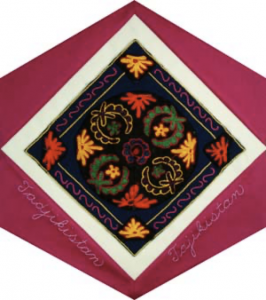Tadjikistan

The Block
Rosa Abramov stays connected to her cultural roots through the music and few household items she brought to Canada with her from Tadjikistan. These treasured items include articles of clothing and the elaborately embroidered hat she has owned for more than 25 years that became the model for this block. Caps, such as that owned by Rosa, are part of the traditional colourful Tadjikistan costume. In addition to beautiful embroidery, they are often ornamented with precious jewels.
Cultural Profile
Tadjikistan, once part of the Soviet Union until its 1991 break-up, is a landlocked nation surrounded by China, Uzbekistan, Afghanistan and Kyrgyzstan. It measures just over 143,000 square kilometers and as such is the smallest country in Central Asia. More than half of Tadjikistan lies above an elevation of 3000 metres. Its beautiful landscape is dominated by mountain ranges, including the Alay Mountains across the north and the Pamir Mountain Range in the south-east. Locals call the Pamir Mountains Bam-i-Dunya, which means “The Roof of the World,” and it takes hardy creatures like the Marco Polo sheep, the evanescent snow leopard and the legendary ‘giant snowman’ to survive the harsh conditions. The population, most of whom live a semi-nomadic existence, is comprised of a majority of Tadjiks, as well as smaller groups such as the Uzbeks and the Russians. Although a variety of tongues and dialects are spoken throughout the country, Tadjik, a relative of the Persian language, is the official language.
Tadjikistan is a major producer of cotton and aluminium, but almost half of its GDP is made of remittances sent from Tajiks working in Russia. The fact that many men have gone away means that women are key players in the local economy as well playing a central role in family life.
The most important celebration in Tadjikistan is Nowruz, which marks the coming of spring in March. Homes receive their annual spring cleaning, visits are made and special dishes are prepared over the course of five days to mark the beginning the season.
Tadjikistan was at one time part of the Silk Road, a major and prosperous trading route between East and West. Through the country’s ever-changing historical landscape, a rich tradition of folklore, legends and poetry has evolved and been passed down the generations. Once such oral practice, dating from prehistoric times, is the epos; a partly historical and partly legendary poem that is performed by a minstrel.
Handcraft traditions also have a long history with expertise being passed on from one generation to the next. Many families produce lengths of spun and woven silk, gold embroidered pieces of clothing and carpets to supplement their incomes. Tajiks are known for the exquisitely embroidered robes and skullcaps, the kolahs, worn by males on special occasions. Women favour multi-coloured and creatively patterned long dresses worn over matching pants, a costume called the chackan. These dresses were worn mostly during celebrations such as weddings or Nowruz, but they are now becoming increasingly popular as they are seen as symbols of the Tajik identity. Kundal ornamentation, where geometric floral forms are painted with great detail and mind-boggling precision, is characteristic of the art done in Tadjikistan. It can be found on buildings, especially mosques. Suzani embroidery is done on various household items. Part of a young bride’s trousseau, these pieces are slowly made over time using silk thread on cotton.
People have been coming to Canada from Tadjikistan since 1993; prior to that they were listed under ‘Russia’ in the Immigration records. As of 2011, there were around 2,400 people of Tajik ancestry living in Canada.
Sponsor: A. L. MacDonald Grocery Ltd.
